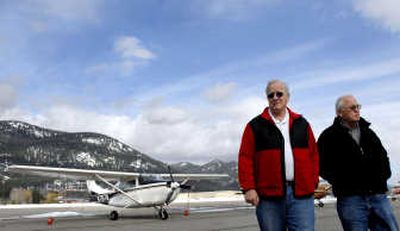Sandpoint Airport wants to grow

SANDPOINT – The Sandpoint Airport is the kind of low-key place where cats wander in and out of visitors’ legs and pilots gather in the morning for coffee, doughnuts and talk about planes.
While Sandpoint Airport boosters don’t want the airport to lose its down-home charm, they’d like to move it into the future by investing in infrastructure that could boost its image and spur regional economic development.
“We want to maintain the ambience of a small airport, but we want to grow as well,” said Sandpoint Airport Board Chairman Terry McConnaughey.
The airport holds great promise for economic growth. Already nearby development is flourishing.
Quest Aviation now employs 200 workers at its factory on the airport’s west side. The company plans to build 16 of its Kodiak planes this year, producing two planes a month by the end of the year. The ultimate goal is to build one plane every 2 1/2 days, said Paul Schaller, Quest president and CEO.
Soon, a field of 44 hangars topped with loft apartments will flank the airport. The $28 million SilverWing project is designed for the flier visiting Sandpoint on business, to hit the slopes at Schweitzer or to enjoy Lake Pend Oreille.
But because both developments are located in the city of Sandpoint, the Bonner County-run airport is unlikely to see much tax benefit despite its role in attracting business.
And future development could be hampered by neglect of the airport itself. With an operations budget of just $73,000 per year and limited money for capital improvements, Sandpoint Airport has been decaying, and supporters warn it could become obsolete if it is not improved soon.
Community leaders are looking for ways to fix the problems, said Bonner County Economic Development Corp. Executive Director Karl Dye.
Built over a weekend in 1966 by a church group using donated materials, the terminal needs to be replaced. Runways need to be resurfaced and a taxiway on the west side of the airport needs to be finished.
A new terminal could cost $1.5 million, McConnaughey said.
The airport will never grow big enough to handle large jet traffic because there isn’t room to expand the runway to handle planes the size of 737s, but it will see a growing number of small jets as business and population growth in Sandpoint continues.
And it could support commuter flights with 20-passenger aircraft.
The airport was briefly home to regular commercial flights, but McCall Air pulled out of the market in 2004 after just four months of service and hasn’t been replaced. The demand the airline needed to make Sandpoint pencil out didn’t materialize.
That means most Sandpoint residents drive to Spokane to catch flights.
Dye said the lack of commercial flights has also led to the impression the Sandpoint Airport only matters to those who own their own planes or can charter executive flights. But the economic development taking place on its edges benefits all of Bonner County, he said.
McConnaughey warned that Sandpoint could lose Quest if the company outgrows the airport. Airport improvements are essential, he said, noting that a similar small-plane manufacturer, Cirrus, left a small Wisconsin city when the airport there stopped meeting its needs. “We don’t want to see what happened with Cirrus happen in Bonner County,” he said.
– Amy Cannata
Cheney sewer hook-up fees to rise
CHENEY – After almost two months of discussion, the Cheney City Council voted to approve raising new sewer hook-up fees from $808 to $4,830.
There was little discussion at the council’s meeting last week before approval of the increase. Several council members said they felt the only opposition to the increase was from builders.
The fees will help offset the cost of a $12 million wastewater treatment plant expansion that should begin later this year.
At the last meeting, the council approved the first reading of a city ordinance that would raise sewer rates by 3 percent, but members amended the ordinance to a 6 percent increase for Eastern Washington University in 2008 and a 4 percent increase from 2009 through 2013.
– Lisa Leinberger
Views mixed in Valley couplet discussion
SPOKANE VALLEY – There was a bit more support for restoring two-way traffic on Spokane Valley’s Sprague-Appleway couplet and for the plan in general in a second round of public testimony recently.
Architect Rustin Hall called the proposed city center at what is now the University City Shopping Center “a bold move.”
“Having two racetracks through the downtown just doesn’t do it,” said Hall, who is chairman of the Greater Spokane Valley Chamber of Commerce.
Creamery operator Dick Behm and dentist Philip Rudy urged planning commissioners to consider a study showing one-way traffic has hurt businesses and is opposed by most of them.
Mostly, though, there was criticism: The plan would clog traffic, cost too much to implement and reduce property values by rezoning commercial land to residential.
Gene Hinkle and Laura Gusdorf introduced a call for a public vote.
“If you’re thinking about using public money, then for goodness sake, put this up for a vote and we’ll settle it once and for all,” Hinkle said.
City officials say the proposed restoration of two-way traffic on Sprague Avenue would be limited at first to the section between Dishman-Mica and University roads.
– John Craig